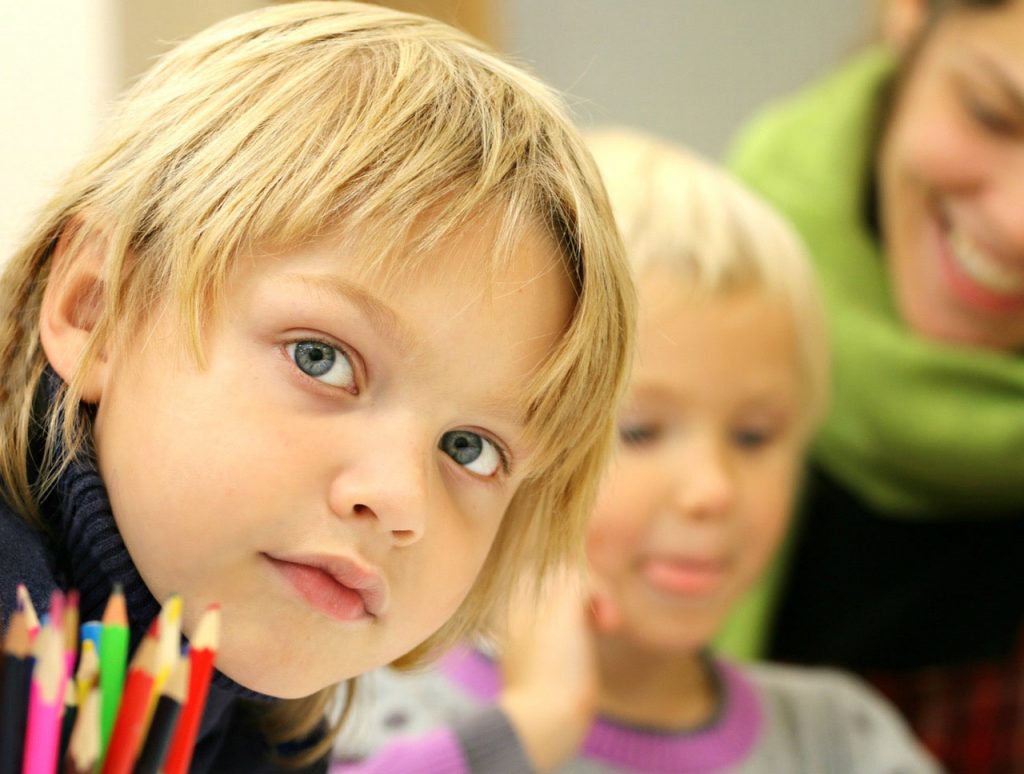Small group time can occur directly after your large group time. Or, you can gather a small group of children together during their free-play time. It’s best to have three to six children in your small groups. If you have enough adults, you can plan small group activities that occur simultaneously in different parts of the room. For example, you lead one small group while your caregiving partner leads another.
Small group activities could be art projects that connect to a large group activity or classroom theme. For example, let’s say your large group activity involved reading The Snowy Day by Ezra Jack Keats and making imaginary snow angels on the big carpet.
Separate your preschoolers into small groups (each lead by an adult), and continue the “snowy day” theme with a related art activity. Gather the children around tables where you’ve placed small, medium, and large circles cut out of white paper; construction paper in different colors; cotton balls; bottles of glue; scissors; silver glitter; and crayons. Each adult leader should encourage the children to think about the story as they create snowy scenes on construction paper. Help your preschoolers to try their own creative ideas. For example, when a preschooler suggests tearing white paper into little pieces for snow, gladly supply her with white paper and ask her to show you what she means.
Small Group Activities
Small group time gives your preschoolers more direct attention from an adult, and an opportunity to be social with their friends. Plan and prepare materials for your small group time in advance so that your children can begin the activity right away. Make this the time of day when your children do not have to share supplies. Be sure each child has his or her personal supply box or his or her own set of supplies (a pair of scissors, a glue bottle or stick, crayons, markers, and more). The sample small group activities below will compliment the large group activities listed here.
Mondays: Create collages. Find pictures, stickers, or fabrics that relate to your classroom theme. Keep this activity fresh by including different materials each week (bottle caps, wooden dowels, dried flowers, fake fur, and more).
Tuesdays: Make hats that relate to the story read at large group time. In advance, cut strips of heavy paper for headbands and paper shapes that compliment the story. If your story was about a rabbit who works for the fire department, for example, you may want to cut paper in the shape of rabbit ears, or in the shape of a fireman’s hat. Let your children color and decorate the hat shapes and headbands before they staple (with your help) the parts together. There are many other ways to connect the story with an art activity, such as finger-painting, papier mache, or making a puppet.
Wednesdays: Play with play dough. Make the play dough together as a group, or prepare it in advance. You can ask your preschoolers to make creations that relate to your group song or fingerplay, or you can allow them to make whatever they like. Supply plastic knives, cookie cutters, and other tools. Before class, draw shapes, and ask your children to “string” the dough around the shapes.
Thursdays: Draw or paint what you saw on your field trip. After your preschoolers have finished drawing or painting, ask them to tell you about their pictures. On another piece of paper, write exactly what they tell you in large, clear print. Then, staple their words to their pictures. Display the pictures at eye level, or make a special “art museum” where children can look at their work throughout the day. Read their words about their pictures to them frequently.
Fridays: On Exploration Fridays, rotate a variety of activities in your schedule. For example, you might cook or prepare a snack; make and play with gak; give each child a pre-made, blank book for “writing” a story (they can make a collage, write, or draw in the book); build with table-top toys; or play-act a simple story. As with the large group activities, you can mix, match, and repeat these activities to suit the needs of your children. Be flexible, and allow your children to continue working on their small group projects during their free-play time, if they choose. Display their work artfully around the classroom. To keep your environment fresh with new work, send home their art once each month. (Remember to keep the samples collected for each child’s assessment portfolios.)


